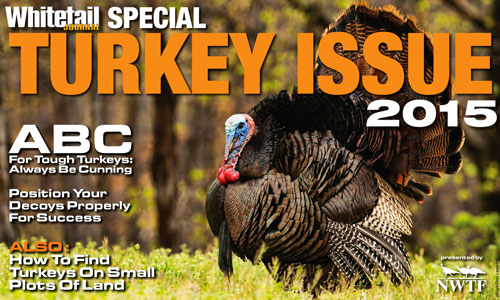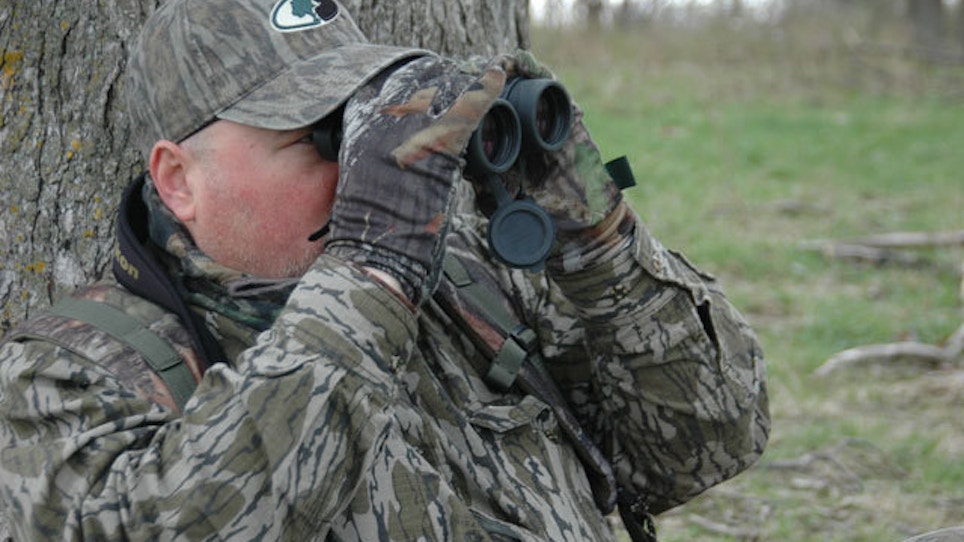Featured in Whitetail Journal's Special Digital Turkey Issue
Turkey hunters tend to live in the present, and why not? When you’re engaged in conversation and battle with one of the most fascinating creatures on the planet, it’s tough not to focus on the moment and soak up every bit of the grand experience.
There’s one slight problem with that, however. Those wonderful heart-pounding moments can quickly turn to heartbreak if you get complacent and fail to anticipate a gobbler’s next move. That’s why it’s critical to think ahead and be ready with a response when a longbeard doesn’t follow the playbook. With apologies to Glengarry Glen Ross, I call it ABC: Always be cunning.
Here’s a look at four common scenarios in which an ABC attitude can save your hunt and fill a tag.
1.) Field Folly
A bird hammers from the roost, and you quietly slip close, settle in and tree-yelp. The response is immediate, and you smile under your facemask. Soon, the bird flies down and cuts off your first calling series. You ready the gun and wait. And wait. And wait some more. Then you see him in an adjacent field, strutting, soaking up the morning sun and slowly drifting away.
Sure, creative calling might lure him in, but it’s more likely that he’ll soon be out of sight. Try to gauge his travel direction, and then make your best guess about where he’ll leave the field and re-enter the woods. Often, turkeys don’t walk the entire length of a field. Like a football player stepping out of bounds at the 30 instead of running through the end zone, birds will travel much of a field only to turn and disappear into the woods. Refer back to your scouting, and remember any pasture gates, logging roads, finger ridges or inviting flats that would be likely entry points. Then, devise and execute a swift but unseen approach to one of those areas.
Does this always work? Of course not, but it succeeds far more often than sitting and yelping fruitlessly at a field turkey. Years ago in Kentucky, Harold Knight and I got on a henned-up gobbler in a large hay field. Knight used the cover of massive white oaks to slip along the woods edge to a small logging road. Minutes later, several hens walked past us out of range in the field but then turned 90 degrees and surrounded us in the woods. The gobbler followed, and he was soon flopping in the wet alfalfa.
2.) Walk-Away Blues
A longbeard’s breakneck approach to your yelping suddenly stalls, and the next gobble sounds farther away. That rat has turned around and is leaving. Was he intercepted by a hen, did he lose interest or did he suddenly decide he needed to be someplace else? It doesn’t matter. Either way, he’s leaving, and if you don’t act, you might never see him again.
This scenario is very similar to that of the field turkey. When the bird turns starts going away, try to keep him gobbling to give you a good idea about his travel direction. Then think about likely ambush spots or turkey-attracting destinations. If he’s walking along a ridge, slip down below his line of sight, get ahead of him and find a good setup. Areas where the ridge hits a T or crossroads are great spots. Is he headed toward a pasture or open field? Make a big loop, and try to intercept him where he might enter the field. Look for roads, gates, timbered points or logging lanes. Is he just seemingly ambling through the woods, heading nowhere? Think of a good setup — a mast-rich flat, cool creek bottom or stand of tall pines — and get there quickly.
A decade ago, a gabby Minnesota gobbler turned tail and started walking out of my life. My buddy — a local who knew the land well — grabbed my arm and pulled me up. “I’ve seen them do this before,” he whispered. “Let’s go.” Minutes later, we were in his truck, high-tailing it to a small woods next to a massive corn-stubble field. I was skeptical, but when my first yelps brought a resounding response, pride went out the window. Minutes later, a light-bulb-white head popped over the ridge at 30 steps, and I completed a great walk-away hunt.
3.) Lines In The Sand
This turkey is somewhat like a walk-away gobbler. He’ll charge in but then stop out of range, gobble his wattles off and not move an inch. Usually, the gobbler is reacting to something, and often, it’s your calling. If you had been playing soft and subtle with him, switch gears, and fire some aggressive yelping and cutting his way. Conversely, if you’d been making his ears bleed, ease off, and switch to sporadic clucking and purring or soft yelping. Perhaps the best tactic on a line-in-the-sand gobbler is to cease calling for at least a half-hour. Often, the turkey will stand and gobble, wondering where the hen has gone. Eventually, most will sneak in for a look. Be careful, because they often do this silently. When a previously hot turkey suddenly goes quiet after your shut-mouth ploy, get your gun ready, because he’s likely on the way.
Another great line-busting tactic is to envision calling scenarios that change a gobbler’s mood. Two springs ago, I watched a longbeard 100 yards distant gobble every five minutes for two hours without moving more than a few feet. Frustrated and late for work, I cutt furiously on a glass call and then used a tube call to produce some jake yelps and a jake gobble. After two or three of these series, the jealous gobbler went ballistic and started a slow, steady march to the gun. Actually, another gobbler joined him, and within minutes, both were within range. I toted one off the hill that morning, thankful that I’d had the presence of mind to try something different.
4.) The Previously Spooked Turkey
We’ve all done it. We’ve slipped too close, made one clumsy move or just plain didn’t use our head and bumped a gobbler over a hill and out of sight. It’s frustrating and regrettable, but it’s not the end of the world. Remember, turkeys get spooked almost every day of their lives. It’s in their nature, and they get over it quickly. The best tactic is to wait a day before hunting the gobbler again. However, that’s not always possible — or necessary.
Note the direction the turkey went, think about likely setups in that area and wait for the woods to calm down. Wait a half-hour or so, and then slowly slip through the timber to that spot, find a good tree or spot for a blind, and listen for a bit. Start with some soft calling to see if the turkey will respond again. Often, it won’t. A turkey can quickly forget a dangerous episode, but being bumped, spooked or flushed will change his mood, at least for a time. Sit and call sparingly for an hour or two, keeping watch for a silent gobbler sneaking in.
Skeptical? One rainy day in New York, a friend and I watched a coyote charge through a breeding flock, sending birds in every direction. Within 20 minutes, the longbeard was gobbling furiously, and he only stopped after his hens had rejoined him. This past season, I made a clumsy move and spooked a gobbler that had slipped in to my left in open timber. After waiting 40 minutes, I slowly walked through the woods, climbed a steep ridge and ran a glass call. The longbeard responded immediately from a nearby field edge. Ten minutes later, he was over my shoulder.
Always Be Cunning
This spring, think ahead, and be ready for any curves a gobbler might throw at you. Your best guesses won’t always work, but they’ll lead to success far more often than if you play it safe and do nothing.






